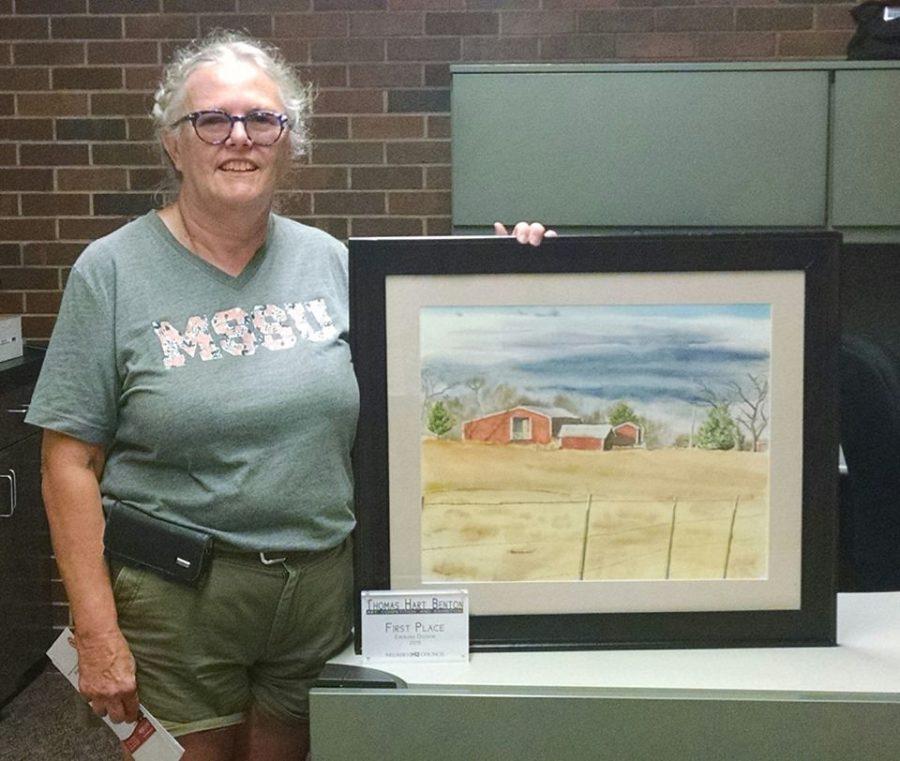Senior art student wins regional competition
Photo courtesy of Susan Griffith
Susan Griffith with watercolor painting Make Hay While the Sun Shines, fist place winner of the 24th annual Thomas Hart Benton Art Competition and Exhibition.
Behind the red barn, the storm clouds roll in, casting shadows over the golden field beyond.
This is the scene near Susan Griffith’s home. Senior bachelor of fine arts major Griffith’s watercolor painting of this scene won first place in the emerging artist category of the Thomas Hart Benton Art Competition and Exhibition.
Born in 1889 in Neosho, MO., Thomas Hart Benton was an American painter and muralist, among working with other mediums. He contributed to the American Regionalist movement where artists’ works depicted scenes from rural and small-town American locations.
Today, his works exhibited in of a variety of locations, including the Art Institute of Chicago, the Museum of Modern Art in New York, and the National Gallery of Art in Washington, D.C.
Because of his local roots, the Thomas Hart Benton Art Competition and Exhibition was designed to honor Benton, and creates an opportunity for local artists to showcase their work to the community.
Griffith’s work parallels some of Benton’s in depicting local landscapes and scenes through art.
Griffith likes to paint scenes near her house, including a bridge in Carthage and the barn depicted in her winning piece “Make Hay While the Sun Shines,” painted in the spring of 2019.
Most of her paintings are landscapes, but she has done some of her other subjects, including her dog and some botanical paintings of fruit.
“[Winning this competition] makes me feel like I’m accomplishing something, and that people like what I do,” she said
Along with first place, Griffith will also have some peer recognition and a regional community audience.
She said watercolor comes rather easily to her, and some of the advantages she likes are that it is neater than oil painting and the paint dries substantially quicker.
However, she said some disadvantages are that brush strokes must be made with intention. Building up colors from light to dark is done carefully, as not to ruin the piece.
Her husband, Duane Griffith said he loves that she’s won this award.
“She’s improving and as long as she keeps at it, I’ll keep pushing her,” he said.
Along with controlling the light in the painting, adjunct painting professor Brenda Sageng said that the quality of the brush strokes are also important. She said that Griffith has improved in handling the paint, including using transparency in her works.
“You’re not necessarily relying on drawing accuracy to convey depth and light but relying more on what the paint surface quality is. The application, does the brush stroke show and does it become an aspect of the work.
Because some of Griffith’s pieces are regionalist, they are meaningful and sometimes tied to specific events like flooding.
Sageng said she thinks Griffith’s early riser tendencies enliven her.
“I think when you live in a rural setting you have an opportunity to be more in tune with what nature feels like, how it changes not just day to day or season to season but from minute to minute,” Sageng said.
Griffith said she would like to build her body of works before considering selling her paintings
Your donation will support the student journalists of Missouri Southern State University. Your contribution will allow us to purchase equipment and cover our annual website hosting costs.






























